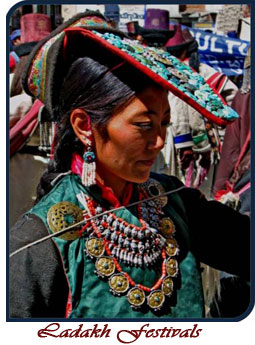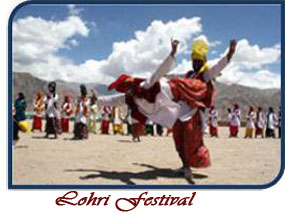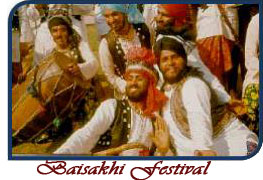Festivals & Fairs...
Festivals of Jammu and Kashmir prove to be the real reflection of the state to the outside world. The state perfectly epitomizes the phrase 'unity in diversity'. The state of J&K has three major regions, Jammu that has majority Hindu population, Kashmir that is dominated by Muslims and Ladakh, a pure Buddhist area. The fairs and festivals of the state bring out the colorful way of living that prevails in the state and the brotherhood that is there among different communities. Every festival here is celebrated by people of all religion together which is a welcome to see in a world torn apart by wars and rifts. The celebration and enthusiasm that permeates the Jammu and Kashmir atmosphere during these festivals is something that can be felt nowhere else on earth.
 Gaffar Tour & Travels offers you an opportunity to glimpse the colorful and happening festivals of the state of Jammu and Kashmir. The most commonly celebrated festivals in Kashmir are Lohri, Baisakhi, Bahu mela, the Jhiri mela, the Mansar food and craft mela, Chaitre Chaudash mela and the Purmandal mela. The Navratras are celebrated with festivities all over Kashmir, but a special mela is held at the Kheer Bhawani temple in the Tulla Mulla village. Kashmir gives you a chance to participate in the other popular festivals such as the Hemis festival and the Sindhu Darshan festival.
Gaffar Tour & Travels offers you an opportunity to glimpse the colorful and happening festivals of the state of Jammu and Kashmir. The most commonly celebrated festivals in Kashmir are Lohri, Baisakhi, Bahu mela, the Jhiri mela, the Mansar food and craft mela, Chaitre Chaudash mela and the Purmandal mela. The Navratras are celebrated with festivities all over Kashmir, but a special mela is held at the Kheer Bhawani temple in the Tulla Mulla village. Kashmir gives you a chance to participate in the other popular festivals such as the Hemis festival and the Sindhu Darshan festival.
Lohri Lohri festival is celebrated on the 13th of January to welcome the onset of spring season and the end of the winter season. The people rejoice on the harvesting of the winter crop at the time of Lohri. Lohri celebrates fertility and the sparkle of life. Lohri is celebrated mainly at night, when people gather round the bonfires. Sweets, puffed rice and popcorn are thrown into the flames and the fire is worshipped. The day of Lohri, in the Hindu month of Paush or Magh, is very auspicious as it marks the entry of Surya (sun) in the 'Makar Rashi' (northern hemisphere).  During the Lohri festival, devotees take a holy dip in the holy rivers/water bodies in different parts of the state. The people of Jammu and Kashmir perform havans and yagnas in their homes and temples. In the rural areas, young children ask for gifts from newly wed couples, new parents and their own elders. Another feature of the Festival of Lohri in the state of Kashmir is the performance of the special Chajja dance. Young boys prepare 'chajjas' with colored paper and flowers and dance on the street, to the beats of drums. A number of traditional songs and dances further add to the festivities of Lohri.
The Jhiri mela is held annually in the memory of a poor farmer who according to popular belief committed suicide to protest against the unfair demands of his landlord.
During the Lohri festival, devotees take a holy dip in the holy rivers/water bodies in different parts of the state. The people of Jammu and Kashmir perform havans and yagnas in their homes and temples. In the rural areas, young children ask for gifts from newly wed couples, new parents and their own elders. Another feature of the Festival of Lohri in the state of Kashmir is the performance of the special Chajja dance. Young boys prepare 'chajjas' with colored paper and flowers and dance on the street, to the beats of drums. A number of traditional songs and dances further add to the festivities of Lohri.
The Jhiri mela is held annually in the memory of a poor farmer who according to popular belief committed suicide to protest against the unfair demands of his landlord.
Jhiri Mela Jhiri Mela is organized in the month of October-November to commemorate the martyrdom of Jitu Baba. Baba Jitu was a simple and honest farmer, who lived in the Jhiri Village, 14 km from Jammu. He was often troubled by his tyrant landlord and harassed to give away his crop. One day, fed up with the oppression, he killed himself, as a protest against the atrocities of the local landlord. The Jhiri Mela is held every year in Kashmir to honor the audacity and integrity of the Baba. It is also believed that on the day of the Jhiri Mela the followers of Baba gather at Jhiri from every corner of North India. Baisakhi Festival  The festival is celebrated on the 13th of April every year. This is a prominent Sikh festival but since the population of Sikhs is quite large in parts of Jammu and Kashmir as well, you will see the enthusiastic celebrations of this festival. It is to celebrate the starting of harvesting season in Northern India. The day also witnesses the start of many fairs, some are even week long. Do visit these fairs as they prove to be great place for shopping for local and traditional items. The day is also famous as the birthday of the tenth Sikh Guru, Guru Gobind Singh. Eid-ul-Fitr and Eid-ul-Azha Eid-ul-Fitr and Eid-ul-Azha are the most famous Muslim festivals in the state of Jammu and Kashmir. If you have to experience the real fun and celebrations of Id, you have to be in Kashmir where the dominant population is of Muslims. Although, the festival is also celebrated in part of Jammu as well. Eid-ul-Fitr marks the end of fasting month of Ramadan. During this day, instead of five-time namaz, people have to offer namaz six times. The day is very auspicious for all Muslims, they wear new clothes and attend many grand feasts. Eid-ul-Azha is equally important festival, which is more prominent for the Qurbani (sacrifice). People sacrifice goats, sheep and some even Camels. Hemis Festival Hemis Festival is the most important festival in Ladakh region. The festival is to commemorate the birth anniversary of Guru Padmasambhava. The festival is organized in the huge courtyard of the largest monastery in Ladakh. The festival is celebrated on the 9th, 10th and 11th day of 5th month according to the Tibetan calendar. It is also believed to be the days when Guru Padmasambhava fought with demons and defeated them. To portray this, Lamas and lay persons dress themselves in traditional clothes and century old masks, and perform a ritual dance depicting the victory of good over evil. Seeing the dance performance in itself is mesmerizing, and the music from drums and long horns only give you an extra reason to get spell bound. Sindhu Darshan Festival This festival is celebrated to honor the River Indus, which is locally known as the Sindhu River. It is believed that India has derived its name from this river. The Indus River is one of the longest rivers in the world. Indus is a trans-Himalayan The River has its source in southwestern Tibet and it flows into the Indian Territory near Leh in Ladakh. Sindhu is basically a Sanskrit word and the name of this mighty river is mentioned in the Rig Veda, that is one of the earliest chronicles of ancient India. |